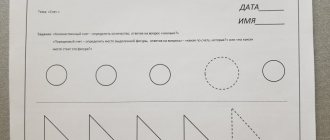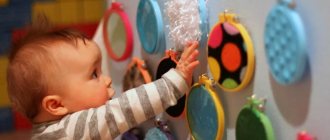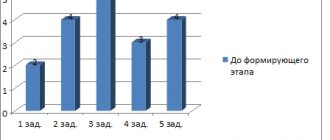DIY: Games and Tools for Sensory Education for Children
Nadezhda Ryazanova
DIY: Games and Tools for Sensory Education for Children
I bring to your attention a selection of games and aids for the sensorimotor development of children that I use in my work. If desired, they can be easily made with your own hands.
Games using hair ties.
1. Game “Palms”:
The game develops fine motor skills, reaction speed, attention, visual perception, the ability to count and distinguish colors.
To play you need 32 cards with tasks, rubber bands (6 colors of 12 pieces each, a bell.
Number of players from 2 to 6. Age from 4 years.
For those who are not yet familiar with this game, I will write its rules: the bell is placed in the center of the table so that each player can easily reach it. Rubber bands are located around the bell, the cards are face down.
The first player turns over one card and places it so that everyone can clearly see it. Players try to match the color of the rubber bands as quickly as possible and put them on their fingers, as shown on the card. The one who completes the task first rings the bell. The remaining players check whether the task was completed correctly. If the player did everything correctly, he takes the card for himself. If he makes a mistake, he misses his turn. The first one to collect 5 cards wins.
Game option: the map with the task opens only for 5 seconds. Then it turns over and the players complete the task from memory.
2. Game “Colored Columns”:
The manual consists of colored columns attached to a board and hair bands. Rubber bands can differ not only in color, but also in shades of the same color. The manual can be used in children’s independent activities, as well as in individual work with children (joint activity of the teacher and the child)
1. For younger preschoolers.
Objectives: to form ideas about color, develop fine motor skills.
Assignment: put an elastic band on a post of the corresponding color.
2. For older people.
Objectives: to form ideas about shades of color, practice counting, consolidate spatial concepts.
Additional equipment - cards with numbers or dots.
The child puts as many rubber bands on the post as there are dots on the card (one more, one less, etc.)
Or: put three elastic bands on the left column, one more on the middle and right columns. There can be as many options as you can think of, depending on the age of the children and learning objectives.
Games using pebbles, beans, pasta, buttons, counting sticks.
All presented games and manuals can be used, starting from early preschool age, in joint activities with the teacher.
Objectives: develop tactile sensations, form ideas about the shape of an object, size, position in space; learn to analyze, find similarities and differences.
Game “Find two identical bags”:
Identical bags are filled in pairs with different fillings: balls, beads, rustling packaging, construction kit parts, etc. Children look for two identical bags by touch.
Tutorial using buttons “Numbers and geometric shapes”
Helps memorize the image of a number and develop the ability to distinguish between numbers and geometric shapes.
Game "Guess by touch"
The child determines by touch which number or geometric figure is “hidden” in the bag.
Game “Following the example”:
The child is offered a sample according to which he completes the task (lays out sticks or writes a pattern, number, letter, geometric figure on semolina).
These cards are tasks that can be used for playing with sticks; they contribute to the development of spatial-imaginative thinking.
Game "Sorter":
The child sorts pasta or pebbles or buttons according to a certain characteristic (by color, size, shape, etc.)
Game "Tic Tac Toe":
For children of senior preschool age.
A set of objects for the development of tactile sensations.
With younger children we examine, examine objects by touch, and talk about sensations. Next we play the game “Wonderful Bag”.
Manual “Sensory Umbrella”:
Clothespins, ribbons of different lengths, widths, colors, and laces are used. Laces for learning to braid, ribbons for fastening colors and shades, for teaching children the ability to find identical ribbons in length and width, the ability to compare, find common features and differences.
Manual "Shoe".
In addition to the tasks listed above, children learn to lace shoes and tie a bow.
Example of a task: lace up your shoe with the longest lace and tie the bow with the shortest ribbon.
Games for hearing development.
a) using jars with different fillings
b) using bells and rattles.
Task: find two objects that sound the same.
Games for consolidating counting, numbers and the alphabet:
On such cards you can write numbers in fives, in pairs, up to 50, up to 100, you can write the alphabet, you can only write vowels.
We place the card in a plastic folder or laminate it, the child uses a felt-tip pen to connect the numbers or letters in order and fill in the missing ones.
Games using a math tablet:
Objectives: develop tactile sensations, fine motor skills; fix color, shape; determine the spatial relationships of parts relative to each other (left, right, above, below, etc.).
You can draw sticks, objects, numbers, letters, labyrinths, corners according to the model and design.
You can also use a variety of task cards.
Games that develop the ability to compare and find common features:
“Octopuses”, “Owls”, Find the animal” (find the animal using the fragment).
Games that form spatial concepts, the ability to navigate on a sheet of paper, the ability to complete a task according to the example:
"Repeat the pattern":
The child traces the outline with a felt-tip pen or plasticine flagella or lays it out with beans.
There are two more manuals that are constantly updated: “Weight Jars” and “Jars with Smells.”
Sources used: blog of Natalia Chistokletova.
Didactic games on sensory education for preschoolers
Sensory perception is aimed at developing sensations and creating a system of reactions to them. Considering that the formation of sensory culture occurs at a deep level of the subconscious, it is necessary to find subtle teaching methods. Simply telling the theory and showing how to behave is an ineffective plan. Sensory education should take place in the process of different types of activities. Didactic games for sensory development turned out to be especially successful.
The concept of sensory
“The child’s mind is at the tips of his fingers” - the words of the Soviet teacher V. Sukhomlinsky accurately reflect the tasks of raising a preschooler. In early childhood (from 1 to 3 years), development occurs through objective activity, in which imaginative thinking is formed. It is important for children to taste an object, feel its structure, and touch the surface. By interacting with surrounding objects, the child learns to perceive and analyze information. The senses and corresponding analyzers help him in this:
Through these systems, ideas about the surrounding reality are formed, which are enshrined in sensory standards - generally accepted properties of objects. Such standards are shapes, colors, size, taste, sound level, temperature.
The sensory system of a preschooler includes two interconnected aspects:
- Mastering ideas about the properties and relationships of objects. The child is looking for new ways to interact with previously unknown objects.
- Mastering new perceptual actions that allow you to more fully perceive the world around you. The child can perform operations not with objects, but with symbols, and becomes able to solve simple problems in his mind, without resorting to trial and error.
Sensory development allows:
- enrich your vocabulary;
- form the correct structure of speech;
- improve cognitive mental processes: memory, attention, thinking, perception;
- develop imagination;
- obtain complete information about the surrounding reality;
- improve communication skills.
A child who has a developed system of perception and processing of information is able to navigate perfectly in the conditions of the modern world.
Games for sensory development of children 2-3 years old
Preschool age is a period of intense sensory development. The child learns about the world through the senses and masters ways of manipulating objects. Sensory is the basis for the emergence of cognitive mental processes and speech. To develop a child’s sensory system, no special conditions or activities are required; you can create sensory games for children 2-3 years old with your own hands.
Card index of didactic games for sensory development of children 2-3 years old
A sensory lesson in the 1st junior group according to the Federal State Educational Standard is held to teach children basic colors, shapes and sizes.
"Button House"
Goal: training the skill of recognizing and distinguishing colors.
Materials: a circle divided into 4 multi-colored sectors, with four buttons to match each sector.
Progress: the teacher explains that each button must find its own home, which matches its color. The child selects a button and places it in the desired sector. The color is called out loud.
"Color Field"
Goal: training the skill of recognizing and distinguishing colors.
Material: circle with colored sectors (number of colors to choose from), which has an analogue of a hand, like in a watch. Children are given a set of cards where the colors match the sectors in the circle.
Progress: the teacher rotates the arrow and shows the color. Children choose the one they want from their cards and show it.
"Air balloons"
Goal: training the skill of recognizing and distinguishing colors.
Materials: several balloons of different colors and ribbons to match them.
Progress: the child is asked to match each ball with a ribbon of the same color.
“What kind of figure is this?”
Goal: to teach the child to find figures in things and objects around.
Materials: cardboard square, triangle and circle.
Progress: the teacher shows the figures one by one and asks the child to walk around the room and find objects that would be similar to them. These could be wheels, an aquarium, plates, a cabinet. You can complicate the task by specifying the color of the objects to look for.
"Hide from the Rain"
Materials: 4 cardboard squares, circles and triangles, as well as three cut out umbrellas.
Progress: the teacher lays out a template, under each umbrella there is one figure. The following describes the game situation: it has started to rain, but the pieces can only hide under their umbrella. The child moves the cards to the correct place.
Important! The teacher is an active participant in each game. Unlike other activities, here he cannot be observed from the outside. The teacher conducts a sensory lesson in the first junior group, directs it in the direction that would better accomplish the task.
Umbrella games have several variations
DIY didactic games
Didactic educational games do not have to be purchased in a specialized store. You can create them yourself and involve your child in the process. This will make him want to learn new things while playing. Household items that a person encounters every day are suitable as equipment. This will introduce the preschooler to everyday objects and avoid additional cash expenses.
Finger dry pool
Dry pool is a game for the development of fine motor skills, which includes finger gymnastics. Fill a deep bowl 12-15 cm high halfway with dry peas. The child dips his hands into the filler, sorts out the peas, and scatters them. In this way, self-massage of the fingers occurs.
Games in a dry pool are accompanied by music or poetry. You can put small toys at the bottom of the bowl, which you need to find and describe with your eyes closed. The game is suitable for children two to three years old.
Salt dough beads game
Children are invited to create beads as a gift for their mother from multi-colored rings. The teacher makes salt dough rings in advance and dries them in the oven. You can buy the dough at the store or make it yourself. For this you will need:
- flour - 1 glass;
- salt - 1 glass;
- starch - 1 tbsp. l.;
- water - 1 ½ cups;
- colored gouache.
Dilute starch in ½ glass of cold water, pour 1 glass of boiling water. Mix half a glass of the resulting solution with flour and salt. Knead the dough, paint it in different colors. Form rings.
During the lesson, children string beads onto a cord and form a decoration.
Guide “put the eggs in your houses”
The teacher paints a cardboard container for eggs in 4 colors: red, blue, green, yellow. Boxes of chocolate eggs (kinder surprise) are covered with appropriate colored paper. Children place colorful eggs into the appropriate cells.
"Tactile Box"
The basis of the interactive manual is a box, a saucepan, and a plastic container with a lid. It is filled with natural materials (cereals, sand, flour, shells, stones, leaves). You can add paper, cotton wool, fabric, toys to the box. The box is supplemented with tools - a spoon, spatula, glasses, muffin tins. The child studies the contents of the box, learns to manipulate different objects, and becomes familiar with various tactile sensations. You can play with the contents of the box according to the instructions of an adult or leave room for the free creativity of a preschooler.
Game "colorful sticks"
Colored counting sticks - Cuisenaire's manual. It is a set of 116 plastic sticks in 10 different colors and sizes. The smallest stick is 10 mm long, the next ones increase by 10 mm. Sticks of the same length are colored the same. Using the manual allows children to develop their understanding of numbers based on counting and measurement, form spatial concepts, and study the “more-less” relationship. You can make your own sticks or buy them at the store.
Wonderful pouch
To play you will need a large thick fabric bag and various small objects: pebbles, figures, balls and beads, coins, fabric, cones. During the game, tactile perception develops. Children take turns putting their hand into the bag and describing the object they felt. The task is to guess what item is in the bag. The lesson is carried out both individually and in a group in kindergarten.
Constructor
Construction is an activity that is aimed at creating new objects from small parts. By assembling the details of the construction set, the child develops imagination, fine motor skills, thinking, and studies colors and shapes.
An adult can offer to assemble a figure according to a model, give an oral task, or allow the child to experiment.
"Spider in the Clearing"
To play, you will need a plastic transparent bucket with a lid; holes are made in it for lacing and attaching additional parts. A spider is glued to a lid made of colored paper. The eyes are made from plastic bottle caps, painted in suitable colors, and connected to the base. Laces are added to the paws and inserted into the holes. From them the child “weaves a web.”
Small objects and ribbons are placed in the bucket, which can be pushed through holes of different diameters. There are many options for manipulating the manual, so children will come up with a new game with the spider every time.
Sources:
https://www.maam.ru/detskijsad/didakticheskie-igry-po-sensorike-sdelanye-svoimi-rukami.html https://vospitanie.guru/doshkolniki/didakticheskie-igry-po-sensornomu-vospitaniyu https:// infourok.ru/sbornik-didakticheskih-igr-po-sensorike-1247589.html https://gotovluskshkole.ru/igry/igry-dlya-sensornogo-razvitiya-detej-2-3-let
Sensory education in children 2-3 years old
In order to purposefully influence the sensory skills of preschoolers, it is necessary to know the main stages of sensory development, be able to diagnose its level and correlate it with age-related characteristics. Among them are the following:
- Getting to know an object through perception through the senses. The child puts it into his mouth, tastes it, feels it, smells it, evaluates its shape and size.
- Formation of skills to correlate the spatial arrangement of objects, connect objects and their parts. The child evaluates the sizes of objects and their relationships. To do this, you need to teach children to put one object into another (games with a pyramid work well), string beads on a cord, and push small objects into various holes. The child becomes familiar with composite objects, with the concept of the whole and parts. Games with large puzzles, cut-out pictures, and construction sets of 2-4 elements will help him with this. At the first stage, the child is able to assemble a matryoshka doll from 2 elements.
- Mastering ways to practically distinguish the properties of objects. A preschooler learns to compare two similar objects through practical actions: putting one on top of the other, the relationship between shape and color. At the second stage, the child is able to assemble a matryoshka doll from 3 elements.
- Formation of manipulative actions with an object based on repeated repetition. After practical manipulations with an object, the child is able to visually correlate the size and shape of objects using only mental operations. He can group objects according to one characteristic, select 3 objects according to a given pattern, and is able to sort objects from smallest to largest. At this stage, the preschooler assembles a five-seater nesting doll.
- Complicating the conditions for performing actions that require correlation according to one of the characteristics. The child groups objects according to several characteristics, is able to correlate 6 or more colors with each other, and visually selects a pair of objects according to given characteristics.
- Using learned actions in solving practical and cognitive problems. The child is able to reproduce acquired knowledge and skills, differentiate the properties of objects, and apply subject standards in solving assigned problems. At this stage, a 3-year-old child can correctly assemble a pyramid of 8 rings in descending order of their size.








